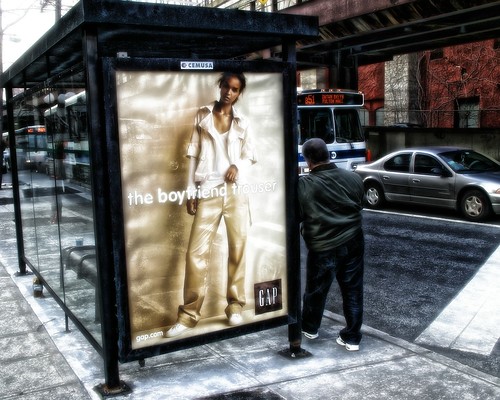In what's sure to be a much more common media play, Gap (in conjunction with out of home agency, Titan) just wrapped up a campaign that combined standard bus & transit ads with geo-fenced mobile display ads. For those of you who may not be familiar with geo-fencing, it's essentially a virtual perimeter in a real-world area. In this case, the mobile display ads utilised the location based services standard in smartphones/tablets to establish that users were within the geo-fenced area. Here's how it worked, people in NYC, San Francisco & Chicago saw standard posters for Gap, but smartphone/tablet users within a specific area around the posters also saw mobile display ad offering Gap coupons if they were on particular sites or playing various games from Zynga, such as Words With Friends.
Dave Etherington, Titan’s senior vice president of marketing and mobile, says that 'The lines are kind of blurring,' he says. 'You’re only a click away now from rich brand experiences and purchases.' He went on to say that Gap & Titan were pleased with the results which has a noticeable, but unspecified, sales uplift. Additionally, 'the campaign, which ran from Feb 20 to March 6, delivered 2.5 million impressions, with a 0.93 percent click-through rate.'
It's a really nice way to enhance the efficacy of standard outdoor ads and I love the potential that geo-fencing and other mobile technologies are starting to offer as a way to bridge the digital and offline to provide true cross-platform experiences.
Supporting articles: PSFK | TechCrunch | eConsultancy
Dave Etherington, Titan’s senior vice president of marketing and mobile, says that 'The lines are kind of blurring,' he says. 'You’re only a click away now from rich brand experiences and purchases.' He went on to say that Gap & Titan were pleased with the results which has a noticeable, but unspecified, sales uplift. Additionally, 'the campaign, which ran from Feb 20 to March 6, delivered 2.5 million impressions, with a 0.93 percent click-through rate.'
It's a really nice way to enhance the efficacy of standard outdoor ads and I love the potential that geo-fencing and other mobile technologies are starting to offer as a way to bridge the digital and offline to provide true cross-platform experiences.
As eConsultancy pointed out, we'd need to know more about the campaign before passing judgement, were the posters near actual Gap stores? Were the results skewed due to it being an offer? No
Supporting articles: PSFK | TechCrunch | eConsultancy

